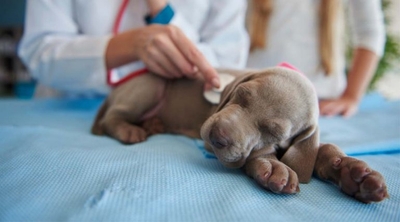Can dogs and cats get diabetes?
2 min read
Yes, but it’s often hard to tell when a dog or cat has diabetes. As is the case with human diabetes, animals with diabetes do not produce enough (or any) insulin or cannot use it properly. Insulin helps their bodies turn glucose (from carbohydrates they’ve eaten) into fuel. Without the correct amount of insulin to convert glucose, the glucose can build up in their bloodstream, leading to various health issues.
What causes diabetes in dogs?
There are some risk factors for diabetes in dogs that you should bear in mind. Middle-aged to older dogs are affected the most. Female dogs who have not been spayed have a higher risk for diabetes as well. Genetics plays a part, of course, as does obesity, just as it does in humans.
The following breeds have a higher risk for developing diabetes: cocker spaniels, dachshunds, Doberman pinschers, German shepherds, golden retrievers, Labrador retrievers, Pomeranians, terriers, toy poodles, and miniature schnauzers.
What causes diabetes in cats?
In cats, age, genetics, and obesity play a part in diabetes just as they do with dogs. Neutered male cats have a higher risk, than cats who suffer from chronic pancreatic issues and hyperthyroidism. An inactive lifestyle and time spent solely indoors also increase a cat’s chance of developing diabetes.
What are the signs of diabetes in dogs?
Warning signs of dogs’ diabetes symptoms may include:
- Excessive hunger but seem malnourished
- Excessive thirst and urination
- Lethargy and more time spent sleeping
- Cloudy eyes
- Hair seems thinner or drier than normal
Cats can exhibit similar symptoms, but a strong symptom of diabetes in cats is if they stop grooming themselves. If your dog or cat exhibits warning signs and has one or more risk factors, please make an appointment with your vet. The earlier your pet starts treatment, the less likely they are to develop cataract formation, blindness, increased susceptibility to infections, weakness in hind legs, and nerve damage.
What should you do if you see signs of diabetes in dogs or cats?
Although diabetes usually affects less than 1 percent of dogs and cats, if you’re concerned that your pet may have diabetes, you might set up an appointment with your veterinarian. The testing for animal diabetes is like the test for humans. There will be a general exam, a urine test for glucose or ketones, and a blood test to determine their glucose levels.
What is the recommended dog diabetes treatment?
The good news is that your pet can lead a long life with treatment and continuous monitoring. You’ll need to monitor their glucose, and they may need daily insulin injections. Although the idea of giving your furry friend daily injections may seem frightening, your vet will be able to coach you through the beginning, and it will soon become a non-stressful fact of life for you and your pet. Diet and exercise will greatly affect your diabetic pet’s health. Your vet can offer advice, but generally, you should provide a diet full of high-quality protein and low-carbohydrate foods.
Exact portions will depend on the size of your pet. Keeping mealtimes and sizes consistent and implementing an exercise routine will go a long way toward helping your pet stay healthy. And, of course, regular checkups with your vet will help you keep an eye out for any changes in your pet’s health. Although a diabetes diagnosis can be scary at first, you and your animal will soon settle into a routine that keeps them healthy.
Learn more about ways to help your dog lose weight and foods to avoid giving to your dog.



